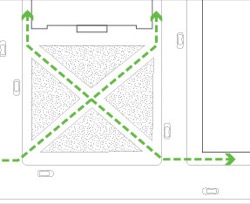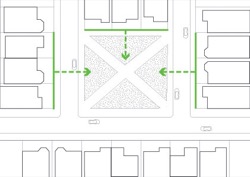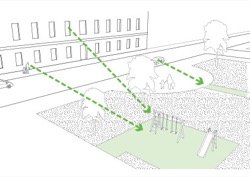On this page:
About local parks
Local parks are green public spaces up to one hectare in size and may include trees, grass, gardens and playgrounds. Some local parks also include water features, cafes or sports facilities.
The location of a park in the movement network often influences its useability. Parks must connect directly to the pedestrian network and be located within easy reach of users.
The most valued parks will be those used by a range of people for a variety of reasons throughout the day. Parks with active uses adjacent to and fronting them are usually more popular than those surrounded by fences and blank walls.
Parks can also support natural systems and habitat.
Why is it important?
Parks provide open space for relaxation, recreation and socialising. They also provide a space to be closer to nature, with relief from the noise, activity and hard surfaces of an urban environment.
Parks also play an important role in enabling people to be more physically active and healthy.
People prefer to use parks that are easy to reach and that feel safe and comfortable. Parks feel and become safer as more people use them.
The success of parks is not just a question of scale or quantity, but where the park is located and how it is arranged.
3.3.1: ensure convenient and safe access to and through local parks
- Locate park entrances on pedestrian desire–lines.
- Provide at least two main pedestrian through-paths across a local park, linked directly to the surrounding pedestrian network.

- Where a principal bicycle route passes through a park, provide separated pedestrian and bicycle paths.
- Locate bicycle paths away from children’s play areas.
- Provide a pedestrian path around the park perimeter for walkers and joggers.
3.3.2: encourage use of local parks at different times of the day by a wide range of users
- Provide areas and facilities suitable for active pursuits.
Tip: circuit training, ball games, skate boarding or kite flying may need designated areas.
- Provide areas and comfortable seating for quiet pursuits.
Tip: seating areas are important for encouraging people, particularly the elderly, to use and enjoy local parks and open spaces.
3.3.3: ensure amenity and safety for local park users
- Surround local parks, on at least three sides, with streets and buildings with active frontages to overlook the park.

Tip: a park bounded by blank rear or side fences limits the opportunity for informal surveillance and reduces security for both park users and properties bordering the park. - Provide seats at the entry points of local parks.
Tip: seating at a park entrance sends a welcoming message, provides a place to meet and lets people feel they can be in the park yet connected to the street outside.
- Locate the paths, facilities and children’s play areas in local parks where they can be seen from surrounding properties, paths and streets.

- Position trees and planting to maintain sightlines between paths within a park and surrounding streets and properties.
- Provide lighting along main paths and in areas intended for night-time use, lit to the same level as surrounding streets.
Tip: using the same lighting levels for park paths as the surrounding areas indicates they are intended as safe routes.
3.3.4: emphasise a sense of place and character in local parks
- Select planting and landscape elements that support the existing character or preferred future character of the park.
- Establish large trees and other plants to enhance the local habitat and microclimate.
- Protect natural features in or nearby to the park that contribute to a sense of place.
3.3.5: ensure local parks are well maintained
- When designing parks, take account of the management agency’s capacity to resource ongoing maintenance and management.
Tip: facilitate the formation of local community ‘Friends of the Park’ associations to participate in ongoing planning and decisions.
- Regularly maintain hard and soft landscape elements to ensure that parks are inviting, comfortable and safe.
- Close access to or do not light park areas intended for day time uses only.
Page last updated: 28/10/25